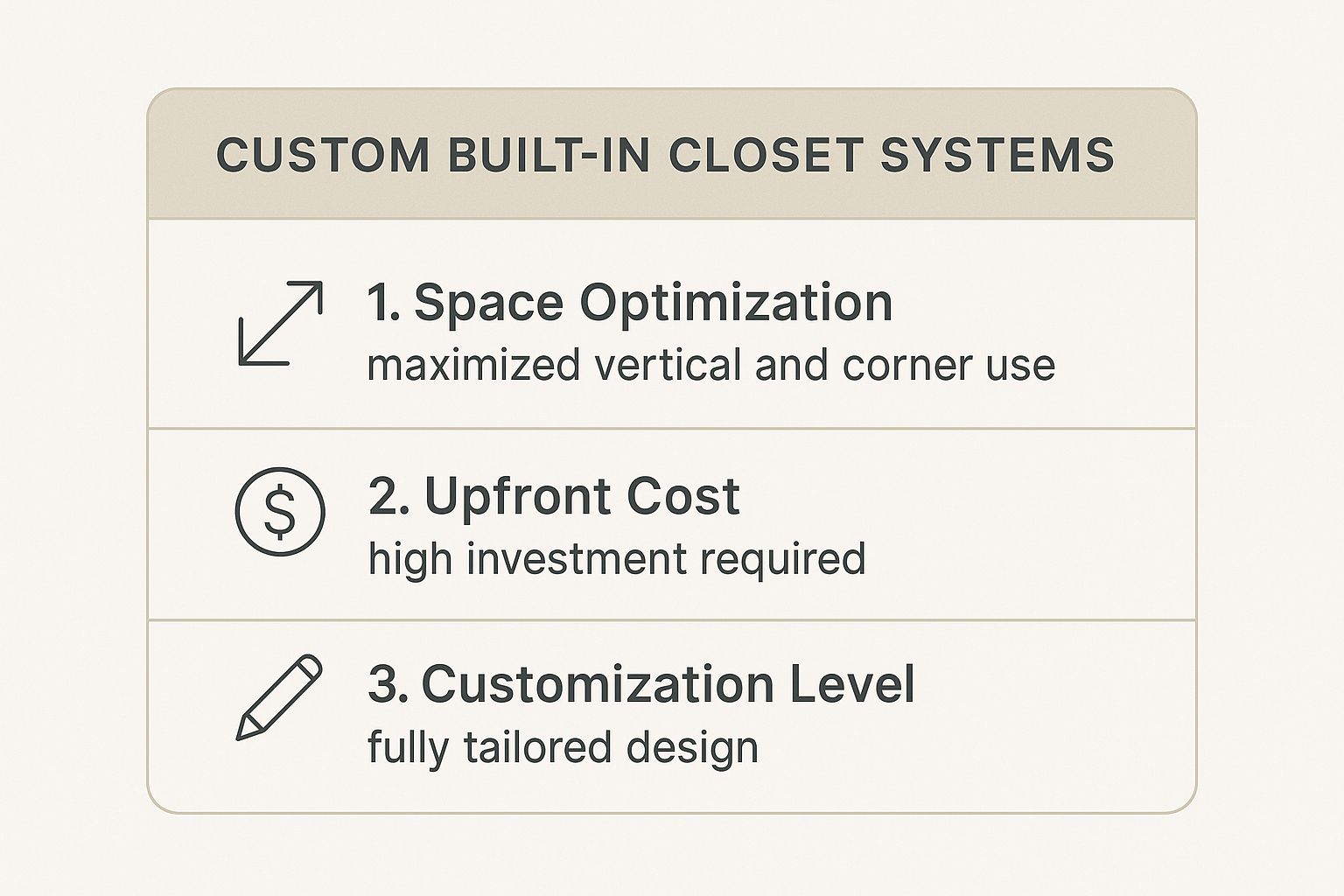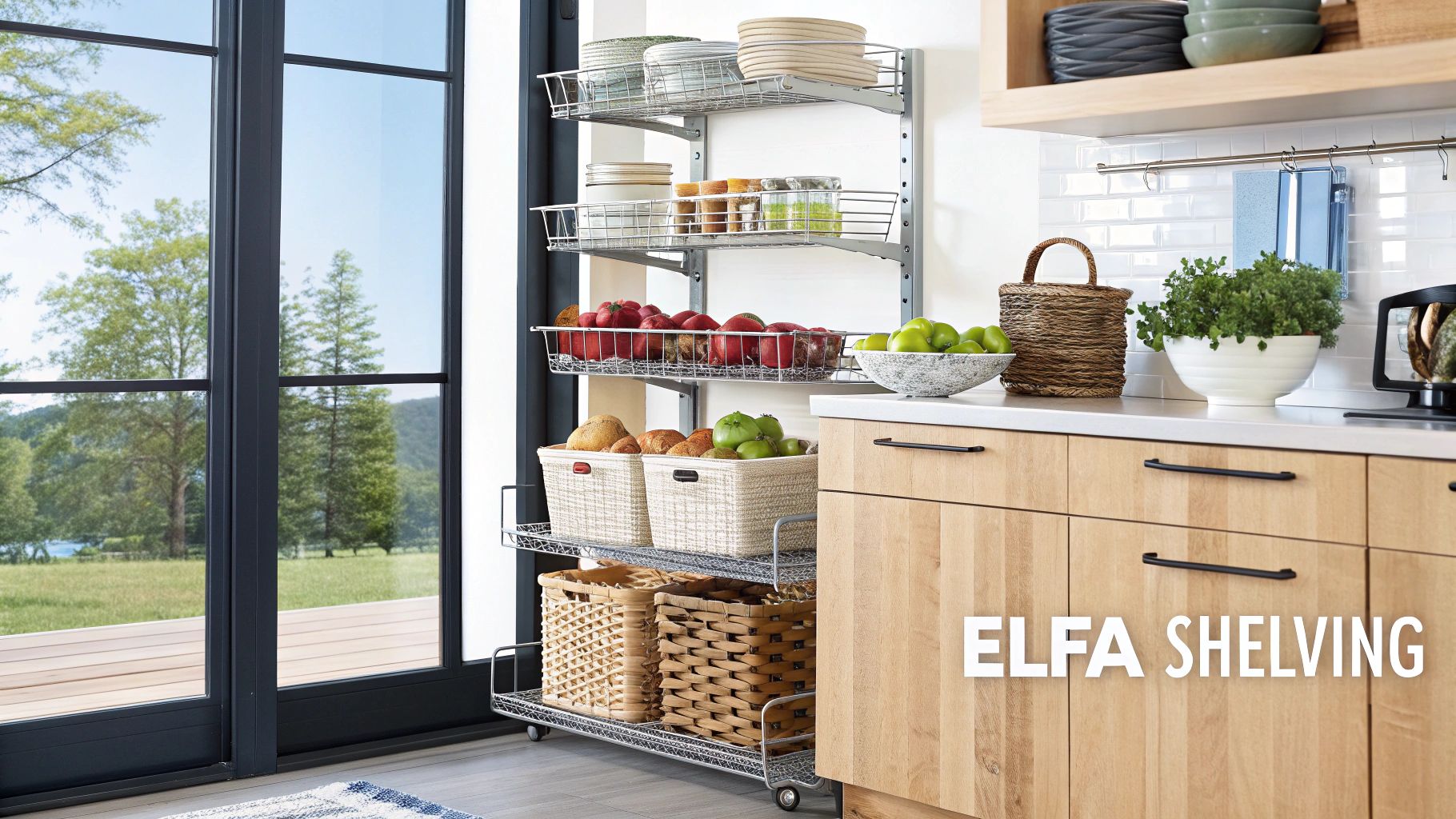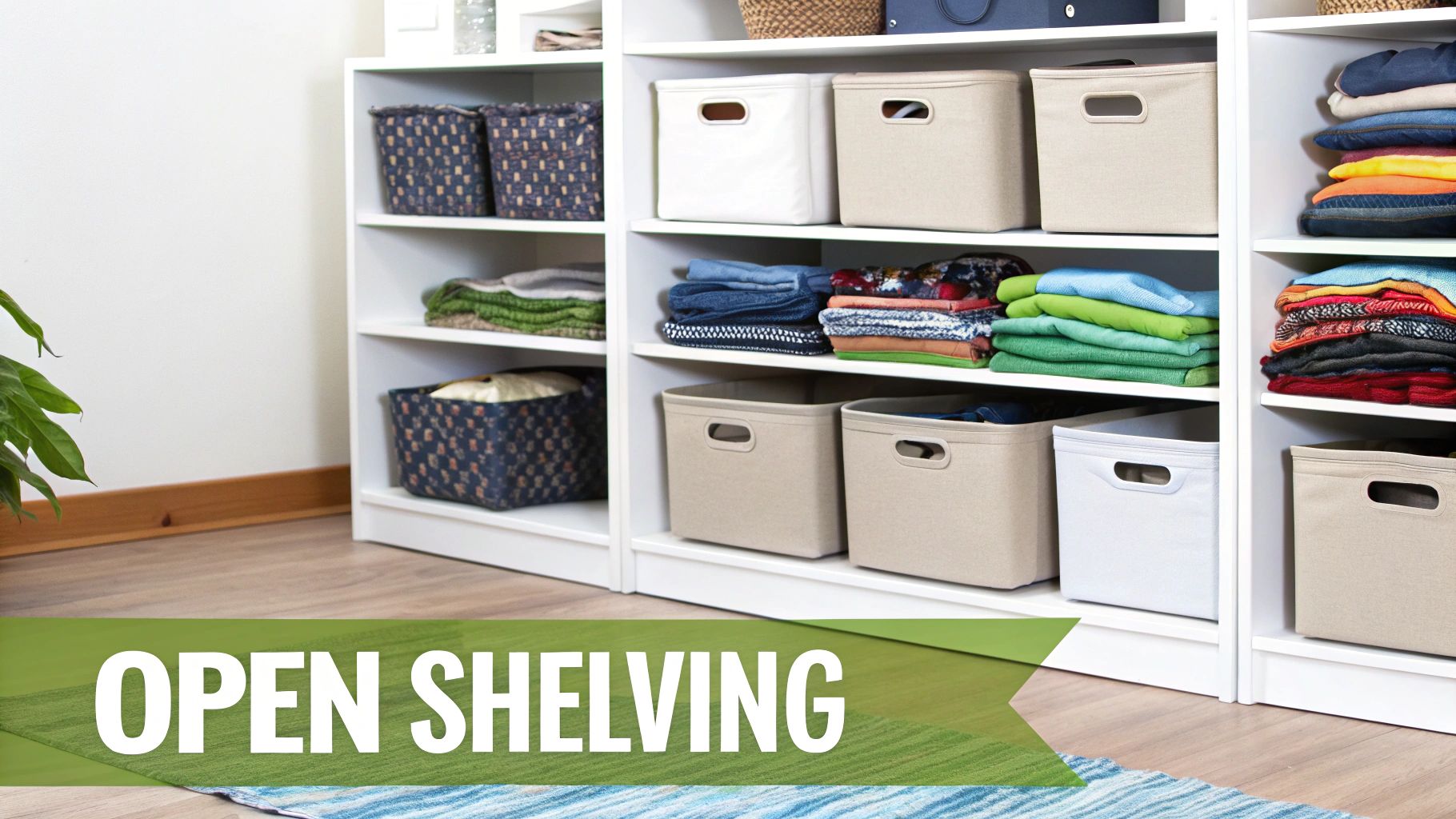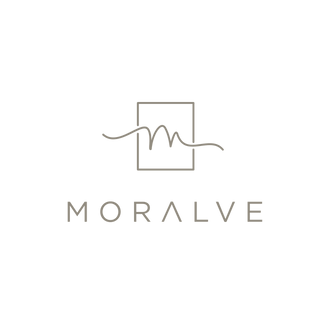9 Best Closet Organization Ideas for a Clutter-Free Space

A well-organized closet does more than just store your clothes; it streamlines your daily routine, reduces stress, and protects your wardrobe investment. But transforming a cluttered space into a functional sanctuary can feel overwhelming. With countless products and strategies available, knowing where to begin is often the hardest part. This guide is designed to cut through that noise and deliver clear, actionable solutions for your closet.
We have curated a definitive list of the 9 best closet organization ideas that provide tangible results for any closet, large or small. Moving beyond generic advice, we will explore everything from comprehensive custom systems to clever, space-saving hacks that maximize every available inch of your closet space.
Each concept is paired with practical implementation details and specific product recommendations, such as innovative space-saving hangers, that elevate simple strategies into powerful, efficient systems. Forget the guesswork and frustration. By the end of this article, you will have a clear roadmap to reclaim your closet, turning chaos into a model of order and accessibility. Let's get started on creating a closet that works for you.
1. Custom Built-In Closet Systems
For those seeking the ultimate solution in wardrobe management, custom built-in closet systems offer unparalleled precision and efficiency. Unlike off-the-shelf organizers, these systems are tailor-made to the exact dimensions of your closet, turning awkward corners and unused vertical areas into functional storage. Companies specializing in closet design install cabinetry, shelving, drawers, and hanging rods that integrate seamlessly into your home, creating a polished, furniture-like appearance.
This approach is one of the best closet organization ideas because it addresses your specific inventory. You can work with a designer to map out dedicated zones for every category of your wardrobe, from long coats to folded knitwear and accessories.
Key Considerations for Built-Ins
When opting for a custom closet system, planning is crucial for long-term satisfaction. Consider these practical implementation details:
- Zone Your Closet: Collaborate with a designer to create dedicated areas. Allocate double-hang rods for shirts and pants, single rods for dresses, and shallow drawers for accessories to ensure everything has a home within the closet.
- Incorporate Smart Features: Maximize convenience with additions like pull-out valet rods for planning outfits, integrated laundry hampers, or even a fold-out ironing board.
- Choose Versatile Finishes: Opt for neutral colors like white, grey, or light wood tones. These finishes not only brighten the closet space but also have broad appeal, which can be a plus for home resale value.
The following summary box highlights the main trade-offs of this high-end organizational method.

The graphic illustrates that while custom systems require a significant upfront investment, they provide unmatched space optimization and personalization for your closet. A well-designed custom closet transforms a standard space into a highly functional and personal wardrobe hub.
2. Modular Wardrobe System (IKEA PAX)
For a highly customizable yet budget-friendly alternative to built-ins, modular wardrobe systems like the IKEA PAX offer incredible versatility. These systems provide a framework of different-sized wardrobe boxes that you can fill with a wide array of interior organizers, such as drawers, shelves, pull-out trays, and hanging rods. This DIY approach empowers you to design a closet solution that perfectly fits your space and storage needs without the high cost of a fully custom job.
This method stands out as one of the best closet organization ideas because it blends affordability with personalization. You can create a sleek, integrated look that rivals expensive installations, making it ideal for anyone from first-time homeowners to renters who need to maximize closet space. The system’s adaptability allows you to reconfigure the interior as your wardrobe evolves over time.
Key Considerations for Modular Systems
To get the most out of a modular system like PAX, strategic planning is essential. Focus on these practical implementation details for a successful setup:
- Map Your Inventory: Before buying, take a full inventory of your clothes and accessories. Use IKEA’s online planner to assign specific KOMPLEMENT organizers to each category, ensuring you have enough space for folded sweaters, hanging dresses, and shoes.
- Create a Seamless Look: For a high-end, built-in appearance, use filler strips between the wardrobe frames and the wall. This simple addition closes any gaps and makes the unit look like a permanent, custom fixture in your closet.
- Choose Space-Saving Doors: In tight spaces, opt for sliding doors instead of hinged ones to save floor space. Mirrored doors are also a great choice as they make small closets feel larger and brighter while serving a practical purpose.
The following summary box highlights the main trade-offs of this popular organizational method.
The graphic shows that while modular systems require self-assembly, they offer an excellent balance of cost, customization, and style for closet organization. By carefully selecting your frames and interiors, you can design a functional and sophisticated wardrobe that perfectly suits your lifestyle and budget. This approach puts powerful closet organization tools directly into your hands.
3. Elfa Wire & Track Systems
For a highly adaptable and modular storage solution, Elfa Wire & Track Systems offer exceptional versatility and strength. Popularized by The Container Store, this system is based on a single horizontal top track mounted to the wall. From this track, vertical standards hang down, allowing you to click shelves, drawers, and other components into place without any tools. The open-wire design promotes air circulation, keeping clothing fresh, and its wall-mounted nature keeps closet floors clear for easy cleaning.
This approach is one of the best closet organization ideas because it is completely adjustable and can be reconfigured as your needs change. It’s perfect for everything from a standard bedroom closet to a hall closet. The system’s airy, minimalist aesthetic also makes small closets feel larger and less cluttered.

Key Considerations for Elfa Systems
Proper planning ensures your Elfa system maximizes every inch of closet space while accommodating your specific storage needs. Consider these practical implementation details:
- Protect Delicate Items: The wire construction is sturdy but can leave impressions on delicate fabrics. Use clear shelf liners on shelves designated for knit sweaters or fine materials to create a smooth, solid surface.
- Vary Your Storage Types: Combine different components for a fully functional closet. Use deep wire baskets for bulky items like sweaters and linens, and shallower drawers for accessories. Integrate gliding shoe racks to keep footwear organized and visible.
- Mix Open and Closed Storage: While the open-wire look is clean, you can easily add privacy and a more polished feel. Incorporate decorative fabric or woven bins onto the shelves to conceal smaller items and add a touch of personal style to your closet.
4. Cube & Open Shelving Modules
For a modern and highly adaptable closet storage solution, cube and open shelving modules offer incredible versatility. These freestanding or wall-mounted units, typically featuring 12-inch to 15-inch cubbies, create a grid-like system perfect for folded clothing, shoes, and accessories. Systems like the IKEA Kallax series are renowned for their simplicity and can be configured to fit walk-in closets, reach-ins, or even serve as stylish closet islands.
This approach is one of the best closet organization ideas because it promotes visual order and accessibility. Unlike deep drawers where items get lost, open cubes allow you to see your entire inventory at a glance, making it easy to grab exactly what you need. This modularity also allows the system to grow or change with your needs, letting you add or reconfigure units over time.

Key Considerations for Cube & Open Shelving
To get the most out of this modular approach, strategic implementation is key to avoiding a cluttered appearance in your closet.
- Contain the Chaos: Use fabric or woven bins that fit snugly inside the cubes to conceal smaller, less uniform items like socks, belts, or scarves. This creates a clean, streamlined look while keeping everything organized.
- Assign and Label: Dedicate specific cubes to certain categories like sweaters, t-shirts, or workout gear. For an even more efficient system, use small, discreet labels on the edge of the shelf or on the front of bins for quick identification.
- Create a Mixed-Storage Wall: Combine cube shelving with other storage elements, such as wall-mounted hooks for bags or a hanging rod above the unit for blouses. This creates a dynamic and highly functional "storage wall" within your closet that caters to different item types.
5. Pull-Out Drawers & Accessory Trays
To elevate your closet from simple storage to a streamlined dressing experience, integrating pull-out drawers and dedicated accessory trays is essential. This method brings smaller, often-lost items like jewelry, belts, ties, and watches into clear view. By installing shallow, partitioned drawers at waist height, you create an accessible and orderly hub for all your accessories, preventing them from becoming a tangled mess in a deep drawer or box.
This approach is one of the best closet organization ideas because it provides a designated, visible home for the finishing touches of any outfit. Systems like IKEA's KOMPLEMENT series, which can be retrofitted with custom inserts, or high-end solutions from custom closet companies, make finding the right accessory effortless and protect delicate items from damage.
Key Considerations for Drawers & Trays
Proper implementation turns a simple drawer into a powerful organizational tool inside your closet. Consider these practical details for maximum efficiency:
- Group and Zone Logically: Organize contents by category and how often you use them. Place everyday items like watches and favorite jewelry in the front-most compartments, with special occasion pieces stored toward the back.
- Prevent Sliding: Use soft, anti-slip liners inside trays to keep items like sunglasses and bracelets from shifting and scratching when you open and close the drawer. Velvet or felt liners are ideal for this purpose.
- Enhance Visibility: Install a small, battery-operated LED strip light just inside the drawer frame. This small addition illuminates the contents, making it easy to distinguish between similar items like dark-colored belts or ties.
This targeted solution is particularly effective for anyone with a significant collection of small accessories that need careful management within their closet. By dedicating specific, easy-to-access space, you ensure these valuable items are both protected and ready to wear.
6. Double-Hanging & Adjustable Rods
One of the simplest yet most effective ways to reclaim unused closet space is by installing double-hanging or adjustable closet rods. This strategy instantly doubles your hanging capacity by creating two parallel tiers, perfect for shorter garments like shirts, blouses, folded pants, and skirts. By dividing the vertical space, you eliminate the empty area typically left beneath a single rod holding shorter clothing.
This method is one of the best closet organization ideas for its sheer efficiency and affordability. Simple DIY rod installations can retrofit almost any reach-in or walk-in closet, turning underutilized height into prime storage real estate without the cost of a full remodel.
Key Considerations for Hanging Rods
Proper planning is essential to ensure your new rod system is functional and doesn't create a cramped closet environment. Consider these practical implementation details:
- Measure for Garment Length: Before installing, measure your clothes. The top rod is typically placed around 80-82 inches from the floor, and the bottom rod around 40-42 inches, leaving just enough clearance for garments on both levels.
- Create Designated Zones: Don't convert the entire closet to double rods. Reserve at least one section with a single rod for longer items like dresses, long coats, and jumpsuits to prevent them from puddling on the floor.
- Use Slim, Uniform Hangers: To maximize the newly created space, switch to slim, non-slip hangers. Their thin profile allows you to fit more items on each rod, while the uniform look creates a clean, organized aesthetic.
The following summary box highlights the main trade-offs of this space-maximizing method.

The graphic illustrates that while this method may require some minor installation, it offers a significant return in storage capacity for a minimal investment. This approach is a foundational step in creating a highly efficient and orderly closet.
7. Over-the-Door & Wall-Mounted Organizers
When floor and rod space are at a premium in your closet, the most effective strategy is to look up and around. Over-the-door and wall-mounted organizers are genius solutions that reclaim unused vertical surfaces, transforming blank walls and the back of your closet door into valuable storage real estate. These tools range from pocketed shoe organizers to hanging racks for accessories, adding capacity without occupying a single square inch of your closet floor.
This method is one of the best closet organization ideas for small or reach-in closets where every bit of space counts. It provides an accessible, visible home for items that often get lost, such as belts, scarves, handbags, and shoes. For instance, an over-the-door shoe rack can free up an entire closet floor, while a wall-mounted pegboard offers a customizable hub for jewelry and hats.
Key Considerations for Vertical Organizers
To implement this space-saving technique effectively, a strategic approach is key to avoiding a cluttered look inside the closet. Consider these practical implementation details:
- Choose Low-Profile Designs: Select organizers that sit flush against the door or wall. This prevents the door from banging against the wall or items getting crushed when the closet is closed.
- Group and Categorize: Dedicate specific organizers to certain item types. Use a clear pocket organizer for cosmetics and small toiletries, a multi-hook rack for scarves and ties, and sturdy wall hooks for heavy tote bags.
- Prioritize Visibility: Opt for clear pockets or open-wire designs whenever possible. Being able to see what you have at a glance makes it much easier to find what you need quickly and helps you remember to use the accessories you own.
Vertical organizers are an affordable and renter-friendly way to dramatically boost your closet’s capacity. They turn previously overlooked areas into highly functional storage zones, making them an essential tool for anyone looking to maximize a tight space.
8. Shoe Storage Solutions
Proper shoe storage is a cornerstone of an organized closet, preventing footwear from becoming a jumbled pile on the floor. Dedicated systems like cubbyholes, tilted shelves, and clear-front boxes keep shoes visible, protected, and easily accessible. By giving each pair a designated spot, you not only preserve their condition but also streamline your daily routine, making it effortless to find the perfect shoes for any outfit.
This approach is one of the best closet organization ideas because it addresses a common source of clutter directly. Systems range from over-the-door hanging pockets for small closets to elegant tilted shoe shelves for extensive collections. Even simple solutions, such as stackable clear shoe boxes, can transform a chaotic closet floor into a neat, functional display.
Key Considerations for Shoe Storage
To implement an effective shoe storage system, it's important to match the solution to your collection and closet space. Consider these practical details:
- Maximize Visibility: Opt for clear containers or open shelving so you can see your entire collection at a glance. If using opaque bins, label them with photos or text for quick identification.
- Rotate Seasonally: Keep in-season shoes in prime, easy-to-reach locations within your closet. Store off-season footwear like boots or sandals in higher or less accessible spots to free up valuable space.
- Utilize Vertical Space: Use over-the-door organizers or multi-tiered racks to take advantage of vertical real estate. This is especially effective in small closets where floor space is limited.
The right shoe organization system protects your investment and makes getting ready significantly more efficient. This dedicated approach turns footwear chaos into a curated and orderly collection within your closet.
9. Clear Bins, Baskets & Labeling
To effectively conquer clutter on closet shelves, clear bins and uniformly styled baskets with labels are an indispensable tool. This method transforms open shelving from a chaotic catch-all into a tidy, categorized storage system. By grouping similar items like seasonal sweaters, accessories, or extra linens into designated containers, you can easily see what you have while maintaining a streamlined, cohesive look.
This approach is one of the best closet organization ideas because it brings order to smaller, hard-to-stack items that often get lost in a closet. Transparent bins offer at-a-glance visibility, while uniform woven baskets create a serene, aesthetically pleasing appearance, especially when paired with clear, consistent labels.
Key Considerations for Bins & Baskets
Proper implementation is key to turning a collection of bins into a functional closet organizational system. Consider these practical details to maximize their impact:
- Group and Categorize: Dedicate specific bins to distinct categories. For example, use one for winter hats and scarves, another for swimwear, and a third for workout gear to simplify finding what you need.
- Embrace Uniformity: For a polished, high-end look, choose bins or baskets of the same style and size. This creates visual harmony on your closet shelves and allows for stable, neat stacking, which maximizes vertical space.
- Label Everything: Use a consistent labeling method, whether it's a label maker, bin clips with inserts, or elegant hang tags. A clear label eliminates guesswork and ensures you can easily find and return items to their proper home in the closet.
The right container strategy can instantly elevate your closet’s functionality and visual appeal. This method is especially effective for managing items that are used infrequently, making seasonal swaps a simple and organized process.
Top 9 Closet Organization Ideas Comparison
| Item | Implementation Complexity 🔄 | Resource Requirements ⚡ | Expected Outcomes 📊 | Ideal Use Cases 💡 | Key Advantages ⭐ |
|---|---|---|---|---|---|
| Custom Built-In Closet Systems | High (professional installation) | High (custom materials & labor) | Maximized space, seamless high-end look | Permanent homes, exact space optimization | Space efficiency, durability, customization |
| Modular Wardrobe System (IKEA PAX) | Medium (DIY assembly) | Moderate (modular parts, tools) | Flexible, personalized, affordable wardrobe | Renters, budget-conscious homeowners | Cost-effective, wide variety, reconfigurable |
| Elfa Wire & Track Systems | Low (DIY, tool-free adjustments) | Low to moderate (hardware, wire) | Flexible, airy storage, budget-friendly | Versatile closet storage, rental spaces | Easy to adjust, visible storage, affordable |
| Cube & Open Shelving Modules | Low (simple DIY assembly) | Low (units and bins) | Modular, accessible, modern look | Visible items, adaptable closet spaces | Expandable, easy to move, stylish |
| Pull-Out Drawers & Accessory Trays | Medium (precise installation) | Moderate (custom drawers/trays) | Organized small items, better accessibility | Jewelry, belts, small accessory storage | Prevents tangling, utilizes drawer space |
| Double-Hanging & Adjustable Rods | Low (simple DIY installation) | Low (rods and hardware) | Doubled hanging capacity for short garments | Small closets, maximizing vertical space | Affordable, space-saving, easy installation |
| Over-the-Door & Wall-Mounted Organizers | Very low (no tools needed for some) | Low (hooks, racks, pockets) | Added storage without floor space impact | Small closets, rentals, temporary solutions | No damage, cost-effective, portable |
| Shoe Storage Solutions | Low to medium (varied complexity) | Low to moderate (cubbies, boxes) | Protected, visible, easy shoe access | Shoe collections, organized footwear storage | Prevents damage, easy inventory, dust protection |
| Clear Bins, Baskets & Labeling | Very low (simple placement) | Low (bins, labels) | Visible, dust-free, organized shelf items | Seasonal storage, linen closets, accessory bins | Visibility, dust protection, flexible |
Your Perfectly Organized Closet Awaits
Transforming your closet from a source of stress into a sanctuary of order is a deliberate and rewarding process. We've explored a comprehensive array of the best closet organization ideas, from the precision of custom built-in systems to the simple genius of over-the-door organizers. The journey to a perfectly functional wardrobe is not about finding a single solution. Instead, it’s about strategically combining these concepts to create a closet system that is uniquely yours.
The ultimate goal is to design a closet that responds intuitively to your lifestyle. Whether you're a fashion enthusiast or a city dweller maximizing a compact space, the principles remain the same: categorize, contain, and conquer the clutter. The most impactful transformations often come from pairing large-scale structures, like modular shelving, with micro-level details that optimize every square inch.
Key Takeaways for Lasting Closet Organization
To ensure your efforts create lasting change, keep these core principles at the forefront of your closet project:
- Verticality is Your Ally: From floor-to-ceiling shelving to tiered shoe racks and multi-garment hangers, always think vertically. Untapped vertical space is the most common source of wasted potential in any closet.
- Visibility Equals Accessibility: The "out of sight, out of mind" principle is the enemy of an organized closet. Employing clear bins, pull-out drawers, and open-faced cube storage ensures you can see what you own, making it easier to find items.
- Flexibility Breeds Longevity: Your needs will change. Opting for adjustable or modular systems, like IKEA PAX or Elfa, allows your closet to evolve with your wardrobe, ensuring it remains functional for years to come.
Your Actionable Path Forward
Feeling motivated but unsure where to start? Don't let overwhelm paralyze you. Begin with a single, manageable step in your closet. Choose one pain point, whether it's your jumbled shoe collection or your overcrowded hanging rod, and implement one of the solutions we've discussed. Success in one small area will build the momentum you need to tackle the entire space.
Remember, the best closet organization ideas are those that simplify your daily routine, reduce decision fatigue, and bring a sense of calm to your life. By thoughtfully applying these strategies, you are not just tidying up a space; you are investing in a more streamlined existence. Your ideal closet is no longer a distant dream, it's a project waiting to happen.
Ready to take the first and most impactful step in reclaiming your closet rod? Explore the innovative space-saving hangers from MORALVE. Their multi-garment designs can instantly multiply your hanging capacity, making them an essential accessory for implementing the best closet organization ideas discussed here. Visit MORALVE to discover how the right hangers can revolutionize your space.


Leave a comment